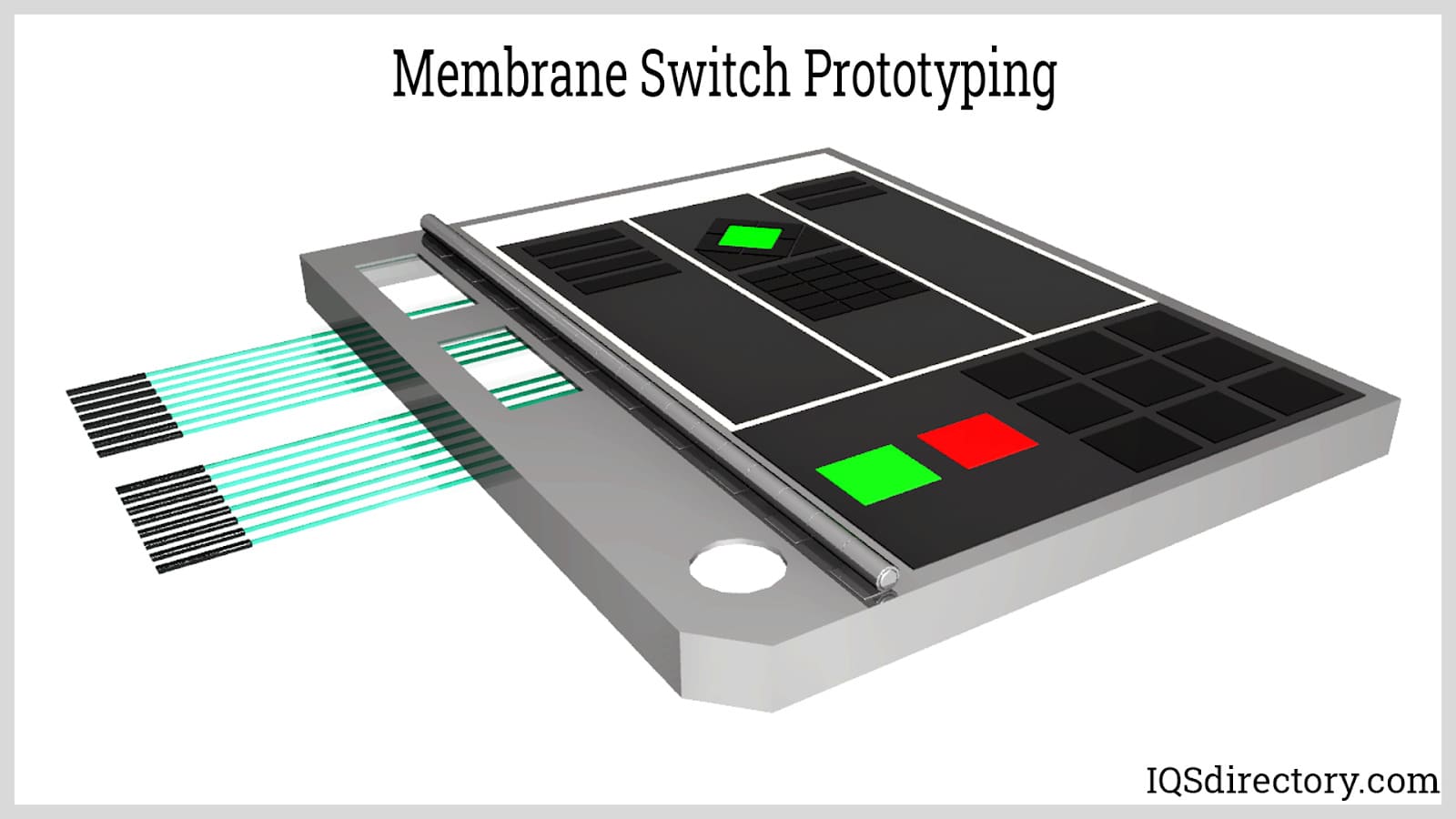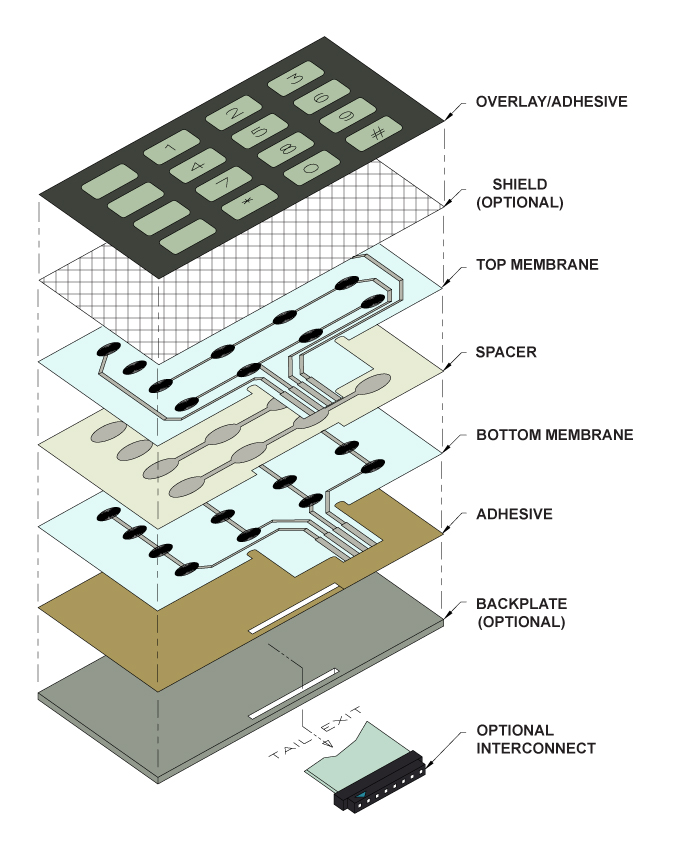All Regarding Membrane Layer Change: Recognizing Its Layout and Performance
When you believe regarding the control user interfaces in contemporary devices, membrane layer buttons frequently come to mind. Let's discover what collections membrane layer switches over apart from various other control systems.
What Are Membrane Layer Buttons?

Membrane layer switches can also be personalized regarding shape, dimension, and graphics, enabling suppliers to develop one-of-a-kind user interfaces tailored to certain items. On the whole, membrane buttons play a considerable duty in boosting customer experience across a broad range of applications.
Exactly How Membrane Switches Over Work
When you push a key on a membrane switch, it triggers a simple yet effective device. membrane switch manufacturer. The leading layer, commonly made of flexible material, presses down onto a conductive layer under it.
You'll notice that the responsive feedback differs based upon the button style, providing either a soft click or a more noticable reaction. When you release the trick, the membrane layer returns to its initial position, resuming the circuit and quiting the signal. This process happens nearly instantly, ensuring a responsive user experience.
Membrane buttons are popular because of their durability and resistance to dirt and wetness, making them optimal for numerous applications, from household devices to medical tools. Comprehending this procedure aids you value their widespread usage.
Trick Parts of Membrane Layer Buttons
Understanding the vital parts of membrane layer switches is essential for realizing their functionality and design. At the core, you'll locate the graphic overlay, which supplies the aesthetic interface for individuals. Under that, there's a spacer layer that divides the circuit layers, guaranteeing that they do not make call till pressed. The circuit layer is where the magic happens; it includes conductive traces that complete the circuit when you press the switch. Another important element is the glue backing, permitting the switch to comply with surface areas securely. Finally, the safety layer guards versus ecological factors and put on, extending the switch's life-span. Each part plays a considerable role in guaranteeing reliable performance and customer interaction. By understanding these components, you'll obtain understanding right into how membrane changes run and their relevance in numerous applications.
Products Made Use Of in Membrane Switch Over Style
The performance and sturdiness of membrane switches over greatly depend upon the products used in their style. You usually experience polyester and polycarbonate as key substrates due to their exceptional toughness and adaptability. These materials withstand scratches and chemicals, making them excellent for requiring environments.
The conductive layers frequently use silver or carbon, selected for their reliability and conductivity. membrane switch manufacturer. Silver provides exceptional performance, while carbon is an affordable choice. For the overlay, you might think about a matte or glossy coating, depending upon your visual demands and individual experience
Adhesives play an important role also; they bond layers safely and guarantee durability. Make specific to select adhesives that stand up to environmental elements like temperature and humidity. Do not overlook the value of a good printing technique for graphics, as it enhances both functionality and aesthetic allure. Choosing the appropriate materials will certainly ensure your membrane layer button stands the test of time.
Layout Considerations for Membrane Layer Buttons
While creating membrane switches, it's vital to take into account different check over here factors that influence their functionality and individual experience. Beginning by concentrating on the format and switch dimension; make specific they're intuitive and simple to navigate.
Confirm your layout accommodates environmental aspects, like moisture or temperature variants, which can impact performance. By thoroughly taking into consideration these components, you'll develop a membrane layer button that boosts functionality and complete satisfaction.
Applications of Membrane Switches
Membrane layer switches are flexible parts located in various applications, from commercial equipment to customer electronics. You'll see their effect in makers that need durable user interfaces and in devices that benefit from smooth designs. Recognizing these applications assists you appreciate the functionality and functionality of membrane buttons in daily innovation.
Industrial Tools Usage
When you're aiming to boost the capability of commercial tools, membrane layer switches supply a trusted option that combines resilience with easy to use style. These buttons are ideal for rough settings, giving resistance to dirt, moisture, and chemicals. You'll discover them in control panels for making machines, cooling and heating systems, and medical gadgets, where accuracy and responsiveness are important. Their reduced profile implies they fit flawlessly right into numerous tools, saving valuable space while preserving ease of use. With customizable graphics and backlighting alternatives, you can produce an instinctive user interface for operators, enhancing effectiveness and safety. Plus, their lengthy lifespan reduces maintenance prices, making them a wise investment for your commercial applications. Accept membrane switches to streamline your operations and boost total performance.
Customer Electronics Combination
In the domain name of consumer electronic devices, membrane layer switches play a vital useful source function in enhancing customer interaction and gadget functionality. Membrane buttons also ensure resilience and resistance to dirt and wetness, extending the life-span of your electronics. By choosing membrane buttons, you improve not just the capability but also the design of your tools, making everyday interactions smooth and enjoyable.
Benefits and Disadvantages of Membrane Switches
While membrane layer switches offer a series of advantages, they additionally come with some downsides that you need to consider. One substantial advantage is their portable design, making them perfect for space-constrained applications. They're likewise cost-efficient, supplying a durable remedy with a low manufacturing price. In enhancement, their smooth surface area is easy to clean, enhancing hygiene in environments like medical facilities.

Nonetheless, there are downsides. Membrane layer buttons can have a much shorter life-span contrasted to mechanical buttons, particularly under hefty use. They can also be less tactile, which could affect individual responses during operation. Moreover, if harmed, fixing them can be tough and usually needs full substitute. Ultimately, their level of sensitivity to extreme temperature levels and ecological problems might restrict their effectiveness in particular setups. Balancing these advantages and disadvantages will help you determine if membrane switches are the best fit for your task.
Often Asked Inquiries
For How Long Do Membrane Changes Usually Last?
Membrane changes generally last in between 5 to ten years, depending upon use and ecological problems. You'll intend to assess aspects like wear, direct exposure to dampness, and why not try here temperature level changes to gauge their durability effectively.
Can Membrane Changes Be Customized for Particular Designs?
Yes, you can personalize membrane layer switches to fit particular styles (membrane switch manufacturer). You'll have the flexibility to select colors, forms, and designs that match your task's demands, guaranteeing they mix seamlessly with your overall aesthetic
What Is the Expense Range for Membrane Change Production?
The cost range for membrane button manufacturing usually falls in between $1 and $10 each, depending upon factors like layout complexity, amount, and products. You can get quotes from manufacturers to find the finest choice.

Are Membrane Switches Over Waterproof or Immune?
Membrane layer switches can be made to be water resistant or resistant, relying on materials made use of and building and construction approaches. If you need them for damp settings, ensure you specify those demands throughout the layout process.
Just How Do Membrane Layer Changes Contrast to Typical Buttons?
Membrane buttons are usually thinner and much more flexible than traditional buttons, using a smooth style. They're commonly much easier to clean and integrate, however could not give the responsive feedback you're utilized to with mechanical alternatives.
Final thought
